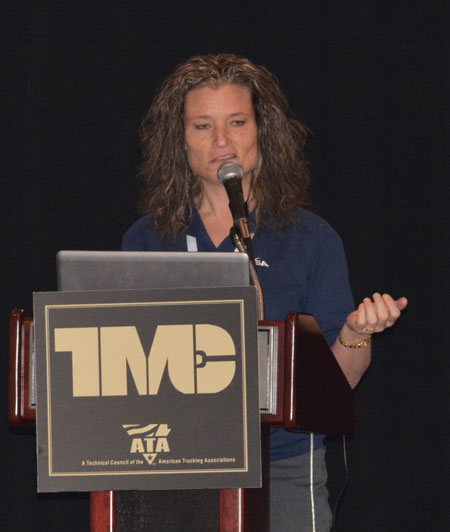Drivers Can Improve Fleets’ CSA Scores By Conducting Better Pre-Trip Checks
This story appears in the March 2 print edition of Transport Topics.
NASHVILLE, Tenn. — In her many years as a roadside inspection officer, Kerri Wirachowsky said she has seen her share of trucks repaired haphazardly with duct tape or traveling down the highway with taillights burnt out.
But what bugs her the most is her perception that truck drivers are not consistently recording deficiencies on their pre-trip inspections.
“Probably 99% of the pre-trips I have seen in my lifetime never have a defect listed,” Wirachowsky told attendees during a session at the annual meeting here of American Trucking Associations’ Technology & Maintenance Council. “Yet, I put about 30% of my trucks out of service.”
Wirachowsky, now a senior enforcement official at Canada’s Ontario Ministry of Transportation, is convinced that if truckers do more thorough pre-trip inspections, carriers would have lower Compliance, Safety, Accountability scores. In addition, more trucks with safety deficiencies could be sent back to the maintenance shop before hitting the road.
 Marsh Galloway
Marsh GallowayWhile U.S. regulators recently eliminated the requirement that drivers fill out pre-trip inspection records unless they find a deficiency, pre-trip inspection reports are still mandatory in Canada.
In 2014, brakes and lights topped the list of violations issued to U.S. motor carriers during roadside inspections, according to federal inspection reports that Wirachowsky cited.
She said there were a total of 823,000 combined brake, turn and taillight violations; 545,000 clearance light violations; 194,000 brake-adjusting issue violations; 93,000 auto brake-adjustment violations; 65,000 auto slack brake-adjustment violations; and 50,000 anti-lock braking systems violations.
Since the advent in 2010 of the CSA Safety Measurement System, many carriers said they are focusing on safety more than ever, and they agree that drivers are a critical link to keeping their SMS scores low.
CSA scores not only have a significant effect on a carrier’s reputation for safety, but they also often are a factor in a company’s bottom line.
Bad scores can trigger more inspections, higher liability insurance costs and a loss of business, said session panelist Chris Reynolds, director of safety and security for Southeastern Freight Lines, which is based in Lexington, South Carolina.
“A big part of this is input from the drivers,” Reynolds said. “It is all about educating drivers.”
Reynolds said his company makes an effort to train its drivers in all aspects of the CSA program, with attention to state, local and service center law enforcement emphasis.
For example, about 25% of all CSA points against carriers nationwide came from five counties in Texas. While only about 20% of Southeastern’s business is in Texas, 55% of its maintenance violations occurred in that state, Reynolds said.
And statistically, Reynolds said, a truck driver is more likely to get a speeding ticket traveling in Indiana than in any other state, and an hours-of-service violation in Georgia.
Law enforcement in Maryland, Mississippi, Texas and Virginia tend to place a heavy emphasis on brake deficiencies, Reynolds said.
The company also takes stock of the CSA weighting system.
Light violations range from two to four points, brake violations typically are four points, while tire tread depth and separation are eight points.
The lower the points a carrier has on its record, the safer it generally is regarded by regulators and shippers.
“If we have one particular driver who has more inspections, we do an immediate follow-up,” Reynolds said. “We develop PowerPoint presentations to communicate either with leadership at a service center or safety supervisors that actually conduct driver meetings.”
Reynolds added, “You cannot communicate enough because, just like any meeting, there will be some drivers whose eyes are glassed over.”
Panelist Mike Durel, eastern division director of maintenance for Saia Inc., said one of the ways his company has improved on its CSA scores is by adding new equipment since 2012.
“We’ve added 2,000 new tractors and 4,200 new trailers into our system,” Durel said. “This allowed us to dispose of our older equipment, our highest-maintenance equipment and our highest-mileage tractors.”
In addition, Saia created and distributes a video to drivers that visually details the entire pre-trip inspection process.
Durel said his company’s analysis of the inspection violation data showed that South Texas and California had the toughest enforcement, while lower violation numbers came mostly from Florida and Louisiana.
Saia also does an inspection every time it services a vehicle, Durel said.
“So we put our hands on our tractors and do inspections as often as we possibly can,” Durel said.

